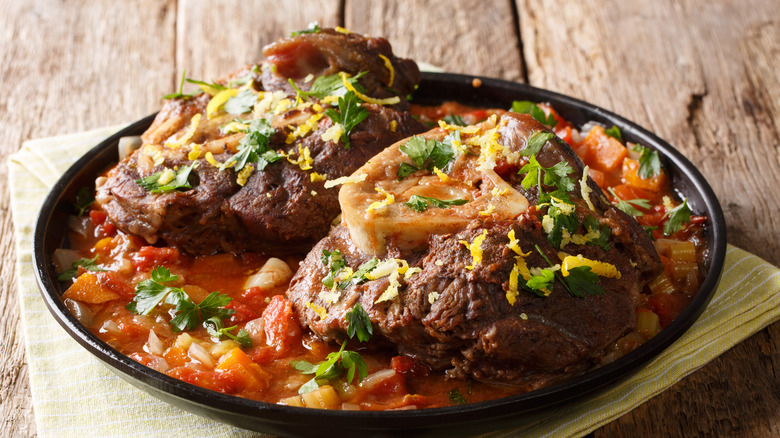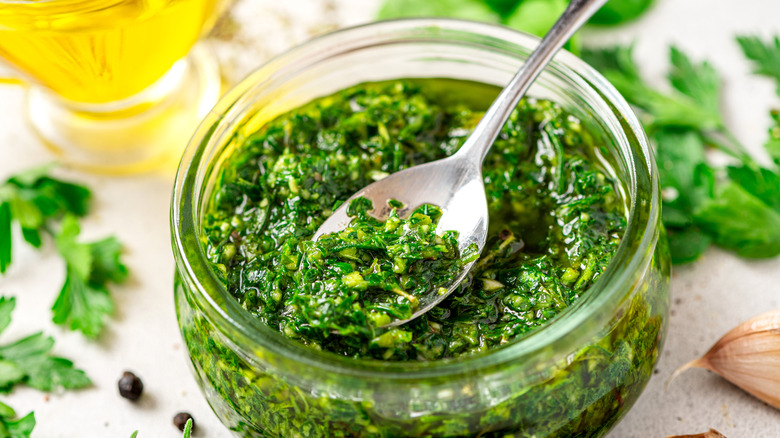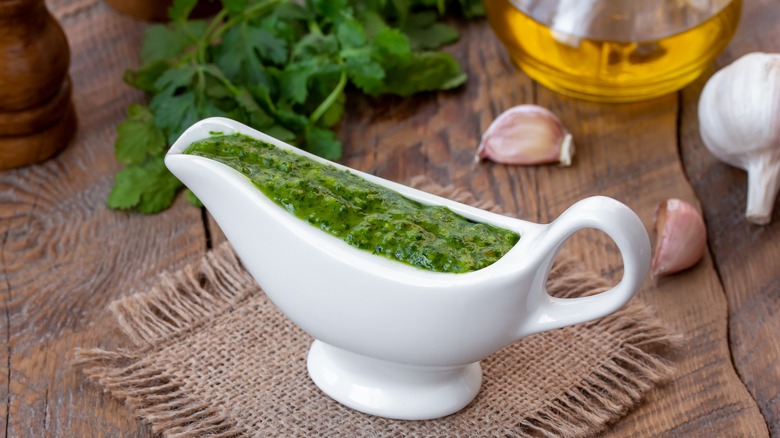The Difference Between Gremolata And Chimichurri
From Italian pesto to Mexican salsa verde and Yemense schug, herbal-flavored sauces take on a range of forms around the world. Each type takes on a distinct flavor and texture, meaning knowing the proper application is paramount for maximum enjoyment. Out of culinary parsley-based sauces, few have a greater contrast than Italian gremolata and Argentina's beloved chimichurri; these aren't two condiments to substitute in a pinch.
The former rests on only three components — lemon zest, parsley and garlic — combined to give rich stewed dishes and seafood an herbal touch. Meanwhile, the latter chimichurri is much heftier in nature, melding herbs with chiles, garlic, oil, and vinegar to make the perfect meat accompaniment. Both come together easily and are aromatic, delicious additions to a prepared meal. And despite their straightforward combination of components, their applications and flavor create quite a bit of distinction to unpack. So let's dive into the details of these two green condiments.
What is gremolata?
Bright and zesty gremolata hails from Lombardy, a region in Northern Italy. In its most traditional form, it's a combination of three components: Flat-leaf parsley, lemon zest, and garlic, although variations may integrate everything from nuts to fruit. Such a mixture is utilized as a condiment upon serving, delivering a tangy, herbal punch of flavor. Gremolata's most classic application is atop osso bucco — Italian-style braised veal shanks — or alongside other rich, slow-cooked meat dishes. Additionally, the herbal mix can be employed on lamb, fish, roasted vegetables, and eggs for a pop of vegetal flavor.
When preparing gremolata, it's critical that the parsley is chopped with a knife rather than a food processor. Such a method will cut the parsley and release oils, rather than mush and soften the herb. Afterward, the lemon zest and garlic can also be chopped into the mix or grated together using a Microplane. The ingredients, alongside some salt and pepper, are melded together in a mortar and pestle or simply vigorously mixed with a spoon. Like other condiments, gremolata can be served tableside as a do-it-yourself garnish and then stored in the fridge for further use.
What is chimichurri?
Herbal and pungent chimichurri is Argentina's beloved seasoning, typically paired with grilled meats. It mixes parsley and oregano with garlic and vinegar, oftentimes in an oil-based emulsion. Each rendition of the sauce takes on its own medley of components and ratios, many of which are regional. In Uruguay, red pepper flakes are typically added for heat. Other renditions alter the oil base, imbuing earthiness through olive oil, or alternatively, favoring less aromatic vegetable oils or even employing water as a liquid base. Plus, many different herbs can go into the chimichurri mix; cilantro, mint, and tea are all utilized additions. Like with gremolata, all components are chopped with a knife to enable a coarser texture.
The result is a sauce with a vivid, complex flavor, matching its herbaceous notes with garlic and chile's spice, all undercut by vinegar's sharpness. It's most commonly served alongside steak and other grilled meats but also appears in choripán sandwiches, alongside meat empanadas, and just about any other meat dish. While some utilize it as a marinade, chimichurri is much more commonly spooned right upon serving.
Chimichurri offers a more assertive flavor than gremolata
Both sauces are herbal in nature, sharing the freshness of chopped parsley with garlic's pungent earthiness as a central flavoring. However, the condiment's further additions greatly alter the resultant character. While gremolata only further mixes in a citrus zest for a bitter note, in a chimichurri, acid is a central component. Whether it's vinegar or citrus, this tang cuts through smokey and meat flavors and lends chimichurri its status as the perfect grilling accompaniment.
Additional ingredients in chimichurri amplify the boldness even further. Many versions reach for chiles, imbuing a spicy character. Others may add onions or shallots, increasing the aromatic pungency. And the use of oregano, often in dried form, delivers a wood-like character. Combining all such additions in a hearty oil base lends chimichurri a much heavier punch of flavor, contrasted with gremolata's more garnish-like nature. Both are delicious, especially when employed alongside the ideal dish but not easily substituted.
Gremolata and chimichurri utilize different applications
Gremolata and chimichurri's flavors and consistencies lend them very different uses in the kitchen. The former is a garnish in nature, adding a zesty, herbal note to dishes with a delicate nature. It won't define the flavors of a meal but instead increase the aromatics of a slow-cooked meat, fish, soup, or salad. The lack of moisture makes no impact on the food's texture, and its dry-chopped nature means it's easier to arrange visually. While gremolata can still be utilized on grilled meats, its ideal purpose is to counterbalance richness or interplay with seafood's salty qualities.
Conversely, chimichurri is a sauce that will stand up to hefty doses of smoke and fat. Its use of vinegar and fat tenderizes meats — the condiment's go-to pairing and likely reason for invention. Such a quality means the sauce can even be used as a marinade or a salad vinaigrette. Whether it's an accompaniment during a steak dinner or spooned into a sandwich, chimichurri functions as a central flavoring component. No surprise, it has become an iconic essential of Argentine cuisine.




